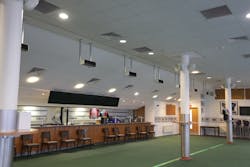London rugby team taps UV-C to tackle coronavirus (UPDATED)
In normal times it would be alarming to report that players from a top English rugby club have been regularly spotted disrobing at the stadium bar.
But we're in the COVID-19 era now, and for the time being, the season ticket holders' lounge is not functioning as a bar. Rather, the London team has decided to use it as a locker room, deeming the usual dressing room at Twickenham Stoop Stadium to be too crammed for good COVID hygiene.
The players now change in and out of game-day regalia in the comparatively airy Honours Bar. The team is called Harlequins, and to further prove that they're not joking around about COVID, Harlequins has taken the extra precaution of adding ultraviolet (UV) radiation to help capture and deactivate coronavirus particles that could be circulating.
Ultraviolet in the “C” band — at 100 to 280 nm — has been proven at certain wavelengths and doses to zap the coronavirus SARS-CoV-2, which causes COVID-19. The UV-C radiation can come from either conventional light technology such as mercury vapor tubes or from LEDs.
Harlequins has installed 11 Philips UV-C upper-air disinfection luminaires from Signify, suspending them from the 3.9m-high (12.7-ft) ceiling to a height of 3.1m (10.2 ft) above the ground. UV-C is harmful to skin and eyes, so the rectangular chambers shield the radiation from direct contact with those below.
The boxes house mercury vapor tubes emitting at 254 nm. The installer —Weybridge, England-based Powercor — spaced them 2.4m (7.9 ft) apart above the 300m2 (3229 ft2) area.
“Before installing, we make calculations of the volume and the needs of a specific space to provide the necessary levels of UV-C disinfection,” a Signify spokesperson told LEDs Magazine. “We typically express that in the number of equivalent air changes per hour, which reflects a level of disinfection that is comparable to the number of times the entire air in a space would be replaced.”
He declined to disclose the level of equivalent air changes, citing competitive reasons.
Like at Edeka, Signify did not enhance existing air circulation, even though HVAC combined with UV-C can make a more potent combination in scrubbing the virus.
“In this case, we make use of the natural convection, as that’s sufficient to achieve the level of equivalent air changes per hour that this particular space requires,” the spokesperson said. “In spaces where natural convection doesn’t result in that, other options of creating sufficient convection can be explored, including HVAC or mechanical circulation.”
In another example from the sports world, the Miami Dolphins National Football League team has installed fittings from Healthe Inc. in its locker room that provide air circulation, ambient lighting, and UV-C LEDs all in one troffer. Kentucky's Big Ass Fans is also combining its ceiling fans with UV-C LED technology. Both Healthe and Big Ass Fans use UV-C LEDs from Crystal IS.
Signify itself recently entered into a partnership with Honeywell, aiming to jointly enhance building health, including in some instances apparently combining UV-C and HVAC into upper-air disinfection systems.
At Twickenham Stoop stadium, the UV-C fittings will continue in operation even after the bar returns to its normal use.
“We are proud to be the first professional sports team in the UK to use UV-C disinfection lighting technology, and we expect to see it widely utilized in future across the sports and events industry,” said Harlequins chief executive Laurie Dalrymple, chief executive of Harlequins, which is currently in third place in Gallagher Premiership Rugby.
The team might also deploy the technology in other areas of the stadium, Signify said.
MARK HALPER is a contributing editor for LEDs Magazine, and an energy, technology, and business journalist ([email protected]).
*Updated Feb. 24, 2021 for coverage area of disinfection units.
For up-to-the-minute LED and SSL updates, why not follow us on Twitter? You’ll find curated content and commentary, as well as information on industry events, webcasts, and surveys on our LinkedIn Company Page and our Facebook page.

Mark Halper | Contributing Editor, LEDs Magazine, and Business/Energy/Technology Journalist
Mark Halper is a freelance business, technology, and science journalist who covers everything from media moguls to subatomic particles. Halper has written from locations around the world for TIME Magazine, Fortune, Forbes, the New York Times, the Financial Times, the Guardian, CBS, Wired, and many others. A US citizen living in Britain, he cut his journalism teeth cutting and pasting copy for an English-language daily newspaper in Mexico City. Halper has a BA in history from Cornell University.




![The DesignLights Consortium continues to make progress in shifting outdoor lighting products and implementation practices toward a more restrained and thoughtful strategy. [Image does not represent a DLC qualified fixture.] The DesignLights Consortium continues to make progress in shifting outdoor lighting products and implementation practices toward a more restrained and thoughtful strategy. [Image does not represent a DLC qualified fixture.]](https://img.ledsmagazine.com/files/base/ebm/leds/image/2024/08/66be810888ae93f656446f61-dreamstime_m_265700653.png?auto=format,compress&fit=&q=45&h=139&height=139&w=250&width=250)
